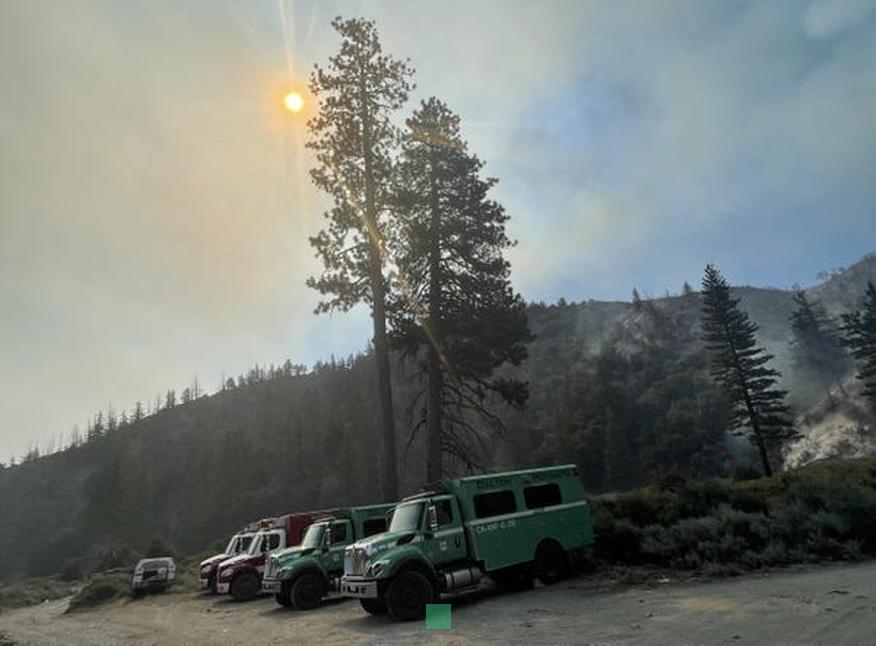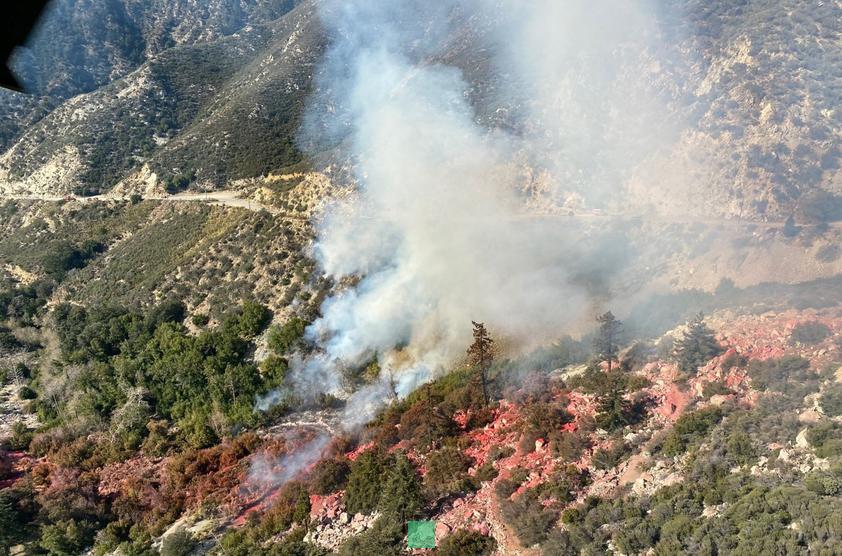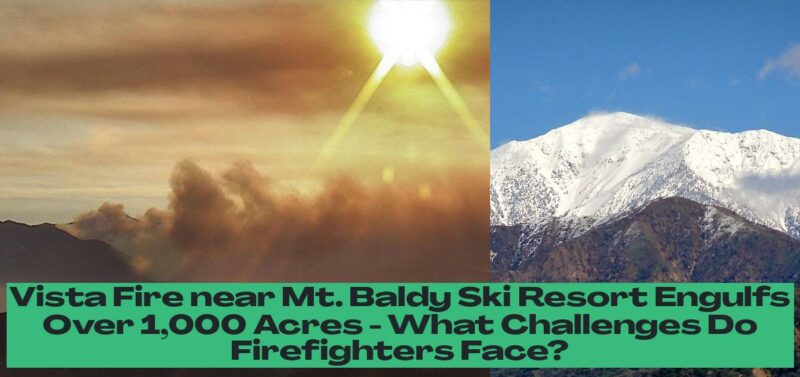Vista Fire near Mt. Baldy Ski Resort surpasses 1,000 acres

The Vista Fire, a blaze that ignited in the San Bernardino National Forest, has relentlessly consumed over 1,000 acres of land, causing widespread closures and raising concerns about the safety of the surrounding communities. The fire, which started on Sunday, has been burning for three days, rapidly spreading through the dry vegetation and posing a significant threat to the Mt. Baldy Ski Resort and nearby hiking trails.
The flames, fueled by the scorching summer heat and low humidity, have been relentless in their advance, reaching 1,095 acres by Tuesday. The fire’s proximity to the Mt. Baldy Ski Resort prompted immediate evacuation orders on Sunday, and the resort has remained closed ever since. Lytle Creek Road, a major thoroughfare leading to the area, has been closed to the public, allowing only residents to access their homes.
More than 350 firefighters are working tirelessly to contain the blaze, facing the daunting task of battling the flames in steep and inaccessible terrain. The fire’s rapid spread and the challenging terrain have made it difficult to establish containment lines, leaving the fire largely uncontained. Incident commanders have highlighted the uphill progression of the fire, emphasizing the need to utilize air resources to slow its advance and cool hot spots on its flanks.
The U.S. Forest Service has issued a warning about poor air quality in the region due to the dense smoke emanating from the fire. Residents and visitors are advised to take precautions to protect their health, particularly those with respiratory conditions. The smoke can cause irritation to the eyes, nose, and throat, and can aggravate existing respiratory problems.
The cause of the Vista Fire is still under investigation. Officials are examining all potential factors, including human activity and natural causes, to determine the source of the blaze. The fire’s rapid spread and its proximity to the Mt. Baldy Ski Resort and surrounding communities highlight the importance of wildfire prevention measures and the need to be aware of the potential hazards during the dry summer months.
- The Vista Fire near Mt. Baldy Ski Resort has surpassed 1,000 acres, posing a significant threat to the area.
- Evacuation orders were issued for the Mt. Baldy Ski Resort and surrounding communities due to the fire’s proximity.
- Over 350 firefighters are working to contain the blaze in challenging terrain, with the fire remaining largely uncontained.
- Poor air quality warnings have been issued due to dense smoke from the fire, urging residents to take precautions, especially those with respiratory conditions.
- The cause of the Vista Fire is still under investigation, emphasizing the importance of wildfire prevention measures during dry summer months.
The Challenges Faced by Firefighters
The Vista Fire has presented firefighters with a series of formidable challenges, demanding their expertise, resilience, and strategic planning. The fire’s relentless advance through steep and inaccessible terrain has significantly hampered their efforts to establish containment lines. The rugged and often treacherous slopes, combined with the dense vegetation, make it difficult for firefighters to access the fire’s perimeter, hindering their ability to effectively deploy resources and combat the blaze.
The fire’s uphill progression adds another layer of complexity to the firefighting efforts. As the flames climb upward, they gain momentum, fueled by the dry vegetation and the wind’s influence. This rapid upward spread makes it extremely challenging to contain the fire’s advance, requiring firefighters to deploy a combination of aerial and ground resources to effectively slow its movement.
Furthermore, the high temperatures and low humidity prevalent in the region exacerbate the fire’s intensity, making it even more difficult to control. The dry conditions allow the fire to spread rapidly, feeding on the abundant fuel sources available in the San Bernardino National Forest. The heat also poses a significant challenge for firefighters, who must work in demanding conditions while wearing heavy protective gear.
The Vista Fire serves as a stark reminder of the importance of wildfire preparedness, highlighting the need for communities to be aware of the risks associated with wildfire season. The fire’s rapid spread and the challenges faced by firefighters underscore the critical role of community involvement in preventing and mitigating the devastating impacts of wildfires.
The Evacuation and Closure of Mt. Baldy Ski Resort

The Vista Fire’s proximity to the popular Mt. Baldy Ski Resort prompted immediate evacuation orders on Sunday, forcing the resort to close its doors to visitors. The resort, a beloved destination for skiers and outdoor enthusiasts, has been a vital part of the local community, providing economic activity and recreational opportunities. However, the wildfire’s relentless advance posed a significant threat to the resort, prompting authorities to prioritize the safety of visitors and staff.
The evacuation of the Mt. Baldy Ski Resort served as a testament to the fire’s rapid spread and the potential danger it posed to surrounding communities. The resort’s closure highlighted the need for swift and decisive action to protect lives and property, underscoring the importance of effective emergency response plans and communication.
The closure of the resort has also had a significant economic impact on the area, disrupting local businesses and tourism activities. The loss of revenue from the resort and the surrounding businesses has highlighted the far-reaching consequences of wildfires, not only in terms of public safety but also in terms of economic stability.
The evacuation and closure of the Mt. Baldy Ski Resort serves as a reminder of the importance of being prepared for wildfire season. It underscores the need for communities to have robust emergency response plans, effective communication systems, and a strong understanding of the potential risks associated with wildfires.
The Importance of Air Resources in Fighting the Vista Fire
The Vista Fire’s rapid spread and the challenging terrain have highlighted the crucial role of air resources in firefighting efforts. Air tankers and helicopters have been instrumental in slowing the fire’s advance, dropping retardant and water on the flames. These aerial resources provide a unique perspective of the fire, allowing firefighters to assess the situation and prioritize areas for intervention.
Air tankers, equipped with large tanks capable of carrying thousands of gallons of retardant, can quickly target the fire’s perimeter, creating firebreaks that slow the flames’ progression. The retardant, a chemical mixture that adheres to vegetation, acts as a barrier, preventing the fire from spreading further.
Helicopters, with their maneuverability and ability to access remote areas, play a vital role in dropping water directly on the flames, cooling hot spots and slowing the fire’s intensity. Helicopters are also used to transport firefighters and equipment to the fire’s perimeter, facilitating access to difficult-to-reach areas.
The use of air resources is a critical element of modern wildfire suppression strategies, enabling firefighters to respond quickly and effectively to large-scale incidents. The Vista Fire’s relentless spread has underscored the importance of these aerial resources, demonstrating their ability to significantly impact the course of a wildfire.
The Importance of Community Involvement in Wildfire Prevention
The Vista Fire serves as a reminder of the importance of community involvement in wildfire prevention and preparedness. The fire’s rapid spread and the challenges faced by firefighters underscore the need for residents to take proactive measures to reduce the risk of wildfires and to be prepared in case of an emergency.
Here are some ways communities can get involved in wildfire prevention:
- Create defensible space around homes: Remove flammable vegetation within 100 feet of structures, trim trees and shrubs, and ensure that roofs and gutters are clear of debris.
- Practice fire safety: Use caution when using machinery and tools that can generate sparks, avoid burning vegetation during high fire danger conditions, and ensure that campfires are extinguished completely.
- Stay informed: Be aware of fire danger levels and evacuation orders, and have a plan in place for how to respond to a wildfire.
- Support local fire departments: Volunteer with local fire departments, donate to fire prevention programs, and participate in community wildfire awareness campaigns.
Community involvement is essential in mitigating the risks associated with wildfires. By taking proactive steps to reduce the risk of fire and by being prepared for emergencies, communities can significantly enhance their resilience and protect lives and property.









